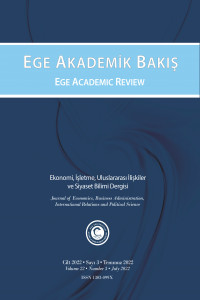Abstract
References
- Klein, T., Thu, H. P., Walther, T. (2018). Bitcoin is Not the New Gold–A Comparison Of Volatility, Correlation, And Portfolio Performance, International Review of Financial Analysis, 59, 105-116.
- Klüppelberg C., Lindner A. and Maller R. A (2004). Continuous Time GARCH Process Driven by A Lévy Process: Stationarity and Second Order Behavior, Journal of Applied Probability, 41(3):601–622.
Abstract
Volatility is an important concept for identifying and predicting the risk of financial products. The aim of the study is to determine the most appropriate discrete model for the volatility of Bitcoin returns using the discrete-time GARCH model and its extensions and compare it with the Lévy driven continuous-time GARCH model. For this purpose, the volatility of Bitcoin returns is modeled using daily data of Bitcoin / United States Dolar exchange rate. By comparing discrete-time models according to information criteria and likelihood values, the All-GARCH model with Johnson's-SU innovations is found to be the most adequate model. The persistence of the volatility and half-life of the volatility of the returns are calculated according to the estimation of the discrete model. This discrete model has been compared with the continuous model in which the Lévy increments are derived from the compound Poisson process using various error measurements. As a conclusion, it is found that the continuous-time GARCH model shows a better performance to predict the volatility.
References
- Klein, T., Thu, H. P., Walther, T. (2018). Bitcoin is Not the New Gold–A Comparison Of Volatility, Correlation, And Portfolio Performance, International Review of Financial Analysis, 59, 105-116.
- Klüppelberg C., Lindner A. and Maller R. A (2004). Continuous Time GARCH Process Driven by A Lévy Process: Stationarity and Second Order Behavior, Journal of Applied Probability, 41(3):601–622.
Details
| Primary Language | English |
|---|---|
| Subjects | Economics |
| Journal Section | Articles |
| Authors | |
| Early Pub Date | June 22, 2022 |
| Publication Date | July 1, 2022 |
| Acceptance Date | May 23, 2022 |
| Published in Issue | Year 2022 Volume: 22 Issue: 3 |

